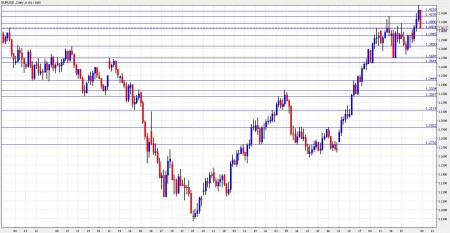After a roller coaster week, another busy week expects Euro/Dollar traders, with GDP releases on Friday being the highlight. Here’s an outlook for the events moving the Euro and an updated technical analysis for EUR/USD.
EUR/USD graph with support and resistance lines on it. Click to enlarge:
EUR/USD enjoyed the QE2 decision but later fell on the good Non-Farm Payrolls in the US. Irish problems are becoming more and more serious – this might get many headlines soon, as well as the indicators. Let’s start:
- German Trade Balance: Monday, 7:00. Germany’s export oriented economy saw a small dip in its surplus last month, dropping to 11.7 billion. A correction is expected this time with a rise to 13.2 billion.
- Sentix Investor Confidence: Monday, 9:30. This is an official survey of 2800 analysts and investors. It showed an improvement in optimism, sending the score to 8.8 points last month. A rise to 10.1 points is expected this time.
- German Industrial Production: Monday, 11:00. The locomotive of the Euro-zone surprised with strong growth in industrial output – 1.7%. Another rise is expected now, but will probably be more mild – 0.6%.
- German Final CPI: Tuesday, 7:00. While the economy is growing nicely in Germany, prices are still stable – a rise of only 0.1% last month according to the initial report. This will probably be confirmed now.
- French Industrial Production: Wednesday, 7:45. Europe’s second largest economy has seen a stall in industrial output last month. It’s now expected to pick up and rise by 0.2%. A drop will hurt the Euro.
- ECB Monthly Bulletin: Thursday, 9:30. The monthly report is published one week after the rate decision. Jean-Claude Trichet and his colleagues decided to leave rates unchanged, given the high level of unemployment. We’ll now get a wide overview of the situation. This release always moves the Euro.
- French GDP: Friday, 6:30. France starts a busy morning of GDP releases. France saw a nice growth rate of 0.7% in Q2. This time, the initial release for Q3 is expected to stand on 0.5% – only slightly lower.
- German GDP: Friday, 7:00. Germany stunned the world with a 2.2% growth rate in Q2, equal to an annualized rate of 9%. After such a leap, growth is expected to get back to normal – a growth rate of 0.8%. Any result, even if it meets expectations, will rock the Euro.
- Flash GDP: Friday, 10:00. While the overall number is released after the two main economies do so, it still rocks the Euro. The strong 1% recorded in Q2 will probably be halved – only 0.5%. The economies of Spain, Greece, Portugal and Ireland weigh on the Euro-zone. Note that this is the first release.
- Industrial Production: Friday, 10:00. This release is overshadowed by the Flash GDP. Nevertheless, a surprise here will move the Euro as well. After a surprising rise of 1.1% last time, a rise of 0.5% is expected this time. Expectations may change after the release of German and French figures.
* All times are GMT.
EUR/USD Technical Analysis
At the beginning of the week, Euro/Dollar struggled under the 1.4030 line (mentioned in last week’s outlook). It then jumped higher but couldn’t settle above the next significant level 1.4217. It finally dropped in the last hours of trade and closed at 1.4131.
With this close, the 1.4030 line became a pivotal line for the Euro. Above, 1.4080 that held temporarily capped the pair provides immediate resistance. 1.4160, which was a high point a few weeks ago, is already more significant resistance.
Higher, 1.4217 capped the pair in January and served as support in December. Even higher, 1.4450 supported and resisted during that same period of time and is relevant in case of a break. The next level is 1.4580 which was a stubborn peak around January as well.
1.3950, which was a pivotal line last week, provides immediate support. Below, 1.3830 was a strong line of support during February and March. The 1.37 support line, which was the bottom beforehand is another minor level of support. 1.3637 already serves as a stronger support line.
Lower, 1.3530 was a support line at the beginning of the year, and had a minor role last month. Just under it, 1.3435 provided strong support in February and is yet another minor line.
1.3334 was a peak in mid August, a peak that held for quite some time. The next lines below are 1.3267, which provided support recently, and 1.3114, which worked in both directions many times in the past. There are more lines below.
I am bearish on EUR/USD.
With QE2 behind us, the Euro-zone still faces serious debt issues, with the focus now on Ireland. The reaction to the American Non-Farm Payrolls showed the Euro’s weakness. Add the high unemployment in Europe and you have significant vulnerability.
Here are some great insights on EUR/USD from other sites:
- Adam Kritzer analyzes the complex picture for EUR/USD after QE2.
- James Chen sees both a weak dollar and a weak Euro in his currency strength/weakness meter. Also Sean Lee sees both currencies go down.
- Andriy sees a steady Euro/Dollar this week.
- TheGeekKnows writes a review of the past week looks forward.
- Casey Stubbs covers this pair regularly.
Further reading on Forex Crunch:
- For a broad view of all the week’s major events worldwide, read the USD outlook.
- For the Japanese yen, read the USD/JPY forecast.
- For GBP/USD (cable), look into the British Pound forecast.
- For the Australian dollar (Aussie), check out the AUD to USD forecast.
- For the New Zealand dollar (kiwi), read the NZD forecast.
- For USD/CAD (loonie), check out the Canadian dollar.
Want to see what other traders are doing in real accounts? Check out Currensee. It’s free..

